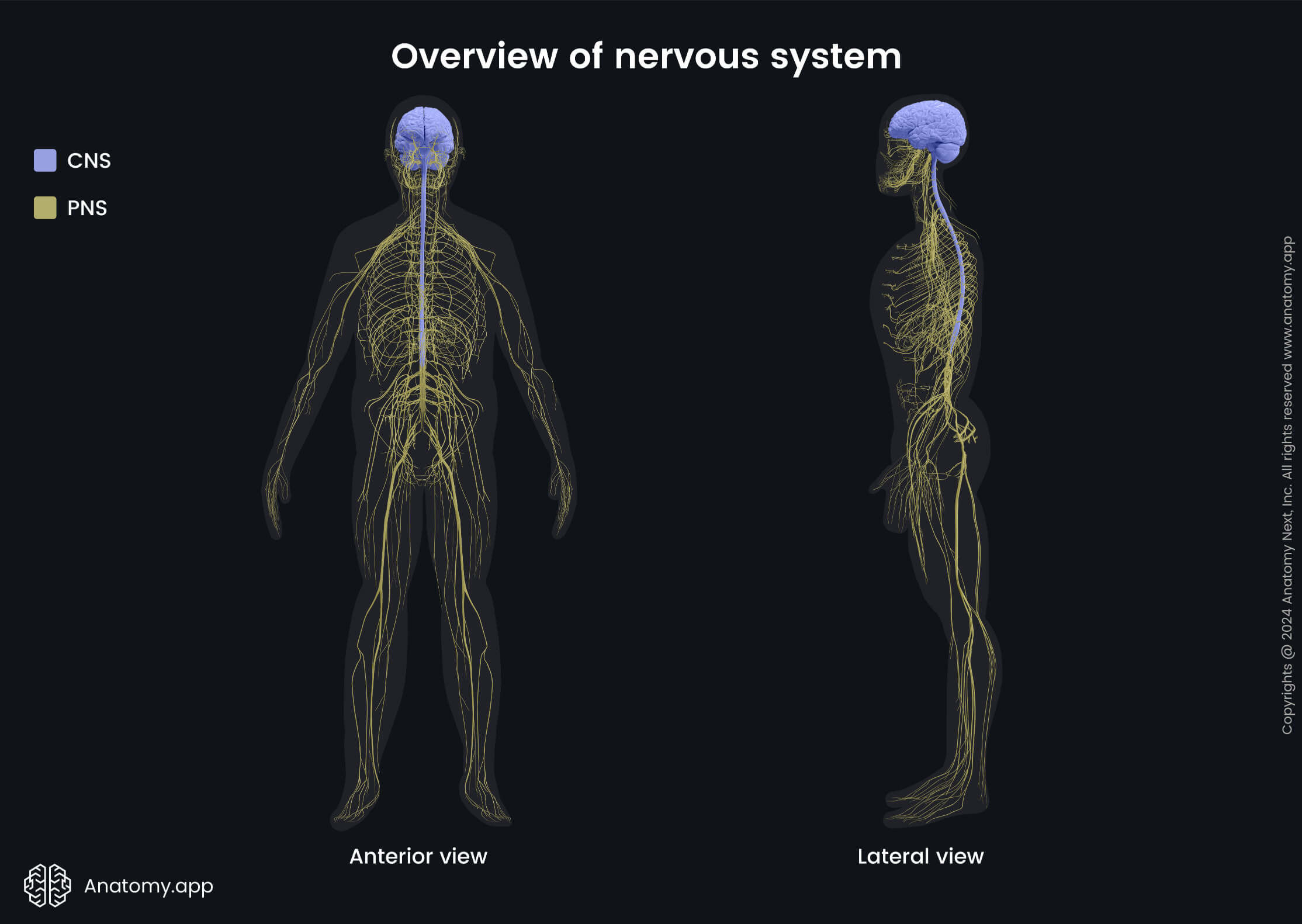Brain (overview)
The brain is the central anatomical part of the nervous system. It is responsible for integrating sensory information, coordinating body functions, and providing complex functions like thinking and feeling.

Some of the main parts of the brain are:
- Brainstem, consisting of medulla oblongata, midbrain and pons
- Cerebellum
- Diencephalon
- Cerebrum, which is made of two cerebral hemispheres
The brain is positioned in the cranial cavity with the bones of the skull protecting it, and it is covered by three layers of connective tissue called the meninges - the dura mater, pia mater, and arachnoid mater.
While the brain composes only 2% of the total body weight (which is around 1.2 - 1.4 kg), it uses approximately 20% of the total energy needed for the body.
Brainstem
The brainstem is the distal part of the brain. It is a link between the cerebrum, cerebellum, and spinal cord.
The common functions of the brainstem include regulation of the heart rate, respiration, blood pressure, and other essential functions.
The brainstem has three parts: medulla oblongata, pons, and midbrain.
- The medulla oblongata is the lower part of the brain and brainstem. The medulla oblongata continues as the pons superiorly, while inferiorly - as the spinal cord. It has two surfaces - ventricular surface and dorsal surface, as well as several sulci on its surfaces. The medulla has two prominences containing nuclei, which are known as the olive and the pyramid. Some of the cranial nerves leave the brain through the medulla oblongata.
- The pons is the middle part of the brainstem. Like the medulla oblongata, also the pons contains nuclei and neural tracts, and is the exit site for some cranial nerves. The pons has two surfaces - anterior (ventral) surface and posterior (dorsal) surface. The posterior surface is connected to the cerebellum via the middle cerebral peduncles, and the inferior portion of the posterior surface is somewhat depressed, forming a superior aspect of an area called the rhomboid fossa, which is the floor of the fourth ventricle.
- The midbrain is the uppermost part of the brainstem. It houses red nucleus, cerebral peduncles, quadrigeminal plate or tectum, as well as the superior colliculus and inferior colliculus. The cerebral aqueduct runs through the midbrain. Two cranial nerves exit through the midbrain.
Cerebellum
The cerebellum is based dorsal to the pons and medulla oblongata and is separated from them by the fourth ventricle.
The cerebellum is mainly responsible for coordination, motor functions, precision, and motor learning.
The cerebellum consists of two cerebellar hemispheres joined by the vermis. It contains four nuclei, grey matter), cerebellar cortex, and medullary core made of white matter and containing mentioned nuclei.
The cerebellum is connected to the different parts of the brainstem via the cerebellar peduncles. It has numerous fissures on its surface and is divided into three lobes:
- Anterior lobe
- Posterior lobe
- Flocculonodular lobe
Diencephalon
The diencephalon is a region of the brain situated above the midbrain. It contains two major brain regions: the thalamus and hypothalamus.
The thalamus processes and integrates all sensory information going to the higher regions of the brain, while the hypothalamus is critical for maintaining homeostasis.
The hypothalamus influences nervous control of all internal organs and is the master regulator of endocrine functions.
The thalamus and hypothalamus both contain specific nuclei.
Cerebrum
The cerebrum is the highest region of the brain made of two almost symmetrical cerebral hemispheres.
Both hemispheres are separated by a deep longitudinal cerebral fissure containing the corpus callosum.
The outer part of the cerebrum is the cerebral cortex formed by the grey matter (mainly built from neuronal cell bodies, dendrites and axonal terminals), and nerve fibres (axons of neurons) forming the white matter.
The cerebral cortex has numerous sulci and gyri on its outer surface. The cerebrum is responsible for conscious sensation, voluntary movement, thinking, learning, and emotions.
The cerebrum is divided into six lobes, including the limbic lobes: the frontal lobe, parietal lobe, temporal lobe, occipital lobe, insula, and limbic lobe.
Each lobe has its own functional areas and functions they are responsible for. There are three types of functional areas: the motor area, sensory area, and association area.
The motor areas provide voluntary control over the muscles, sensory areas receive sensory input, and association areas provide more complex functions such as thinking, learning, decision making, and complex movements like writing and speaking.